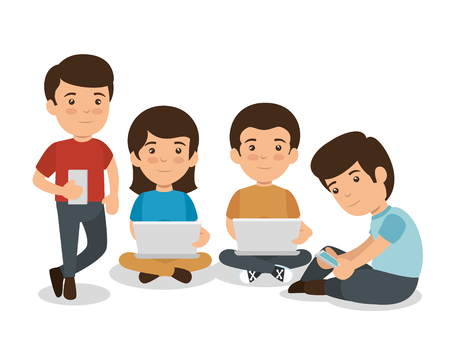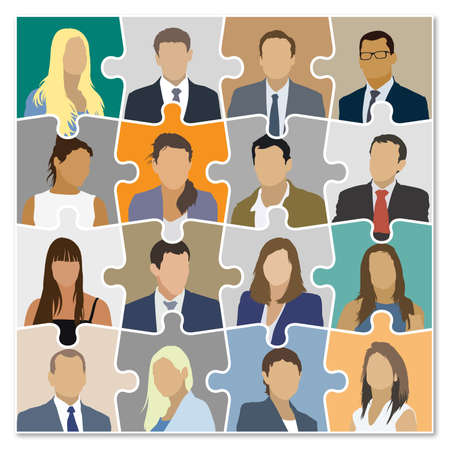1. Understanding the Multigenerational Workforce
Today’s American workplace is more age-diverse than ever before. Employees from different generations bring a wide range of experiences, values, and communication styles to their teams. To truly bridge the generation gap and foster effective teamwork, it’s important to understand who makes up the workforce and what drives each group.
Meet the Generations in Today’s Workplace
| Generation | Birth Years | Key Values | Preferred Communication Style |
|---|---|---|---|
| Baby Boomers | 1946–1964 | Loyalty, hard work, teamwork | Face-to-face meetings, phone calls |
| Generation X | 1965–1980 | Independence, flexibility, efficiency | Email, direct communication |
| Millennials (Gen Y) | 1981–1996 | Collaboration, feedback, purpose-driven work | Texting, instant messaging, video calls |
| Generation Z | 1997–2012 | Diversity, innovation, social responsibility | Social media, apps, short-form messaging |
Values and Work Styles: More Alike Than Different?
While each generation has its unique traits, many values overlap across age groups. For example, everyone appreciates respect and wants to feel valued at work. However, misunderstandings can happen when team members assume that others think or communicate just like they do.
Common Misconceptions and Stereotypes
- Younger workers lack work ethic: In reality, younger employees often work hard but may prefer flexible hours or remote options.
- Older employees resist change: Many experienced workers are open to new ideas but appreciate training and clear explanations for changes.
- Younger generations only want praise: While feedback is important to Millennials and Gen Z, they also value constructive criticism and opportunities to grow.
- Boomers don’t use technology: Most Baby Boomers use smartphones and computers daily; they may simply have different preferences for certain tools.
The Importance of Open-Mindedness
Acknowledging these differences—and seeing past stereotypes—is the first step to building strong multigenerational teams. When people understand where their coworkers are coming from, it’s easier to communicate effectively and reach common goals.
2. Recognizing the Value of Generational Diversity
Understanding Generational Strengths
In today’s workplace, teams are often made up of people from different generations, each with their own experiences and ways of thinking. When we talk about bridging the generation gap, it’s important to recognize that every age group brings something unique to the table. Appreciating these differences can help teams work better together and achieve more.
What Each Generation Brings to the Team
| Generation | Key Strengths | Unique Contributions |
|---|---|---|
| Baby Boomers (born 1946-1964) | Loyalty, experience, strong work ethic | Mentorship, historical perspective, consistency in processes |
| Generation X (born 1965-1980) | Independence, adaptability, problem-solving skills | Efficient project management, resourcefulness, bridging traditional and modern practices |
| Millennials (born 1981-1996) | Tech-savvy, collaborative, socially conscious | Digital innovation, teamwork focus, values-driven approaches |
| Generation Z (born 1997-2012) | Creative thinking, digital fluency, openness to change | Fresh perspectives, quick adoption of new tools, challenging the status quo |
Driving Innovation Through Differences
Diversity across generations is a powerful driver for innovation. When people with different backgrounds and viewpoints come together, they can solve problems in new ways. For example, experienced team members might offer insights based on past challenges, while younger teammates may suggest using new technologies or methods. By blending these strengths, teams can become more creative and productive.
Creating a Culture That Values All Ages
The key is to build a team culture where everyone feels their contributions matter—no matter their age. Encourage open communication and invite input from all team members. When people see that their ideas are valued, they’re more likely to share them, leading to better results for everyone.

3. Fostering Open Communication
Why Open Communication Matters in Multi-Generational Teams
Open communication is the backbone of successful teamwork, especially when team members come from different age groups. Each generation brings unique perspectives and experiences to the table. Encouraging honest and respectful dialogue helps everyone feel valued and understood, which leads to stronger collaboration and better results.
Practical Strategies for Honest, Respectful Dialogue
1. Set Ground Rules for Communication
Start by agreeing on some simple ground rules to guide conversations. These could include:
| Rule | Description |
|---|---|
| Respect All Opinions | Acknowledge everyone’s input, even if you disagree. |
| No Interruptions | Let people finish speaking before responding. |
| Use Clear Language | Avoid jargon or slang that others may not understand. |
| Ask Questions | If something isn’t clear, ask for clarification instead of making assumptions. |
2. Promote Active Listening
Active listening means giving your full attention when someone else is speaking. It shows respect and helps avoid misunderstandings. Try these tips:
- Maintain eye contact without staring.
- Nod or give small verbal cues like “I see” or “Go on.”
- Repeat back what you heard to confirm understanding.
- Avoid distractions like checking your phone during meetings.
3. Use Technology Wisely
Different generations may have different comfort levels with technology. Use a mix of communication tools (like email, chat apps, and video calls) and offer brief training if needed so everyone can participate fully.
4. Encourage Regular Feedback
Create a safe space where team members can give and receive feedback openly. This can be done through regular check-ins or anonymous surveys, making it easier for everyone to share their thoughts honestly.
Sample Feedback Questions:
- What’s working well in our team communication?
- What could we do differently to improve understanding?
- How comfortable do you feel sharing your ideas?
By focusing on these strategies, teams can bridge generational differences and build a culture of trust and respect that benefits everyone involved.
4. Building Inclusive Team Practices
Creating an inclusive team culture is key to bridging the generation gap and unlocking the strengths of every team member, no matter their age. When everyone feels heard and respected, collaboration thrives. Here are some actionable steps you can take to make sure all generational voices are valued and teamwork is top priority:
Encourage Open Communication
Foster an environment where everyone feels comfortable sharing ideas or concerns. Regular check-ins, open-door policies, and anonymous feedback options help people speak up without fear.
Communication Tips by Generation
| Generation | Preferred Communication Style | Actionable Step |
|---|---|---|
| Baby Boomers | Face-to-face meetings, phone calls | Schedule regular in-person or virtual meetings |
| Generation X | Email, direct conversations | Send clear emails; follow up with brief chats if needed |
| Millennials | Instant messaging, collaborative platforms | Use tools like Slack or Teams for quick updates |
| Gen Z | Texting, short videos, social media-style updates | Incorporate video messages or interactive posts for updates |
Promote Collaboration Over Competition
Create opportunities for cross-generational teamwork. Pair employees from different age groups on projects or in mentorship programs. This helps everyone learn from each other and build trust.
Collaboration Ideas You Can Try:
- Mentorship Circles: Mix team members from different generations to share skills and experiences.
- Reverse Mentoring: Let younger employees teach digital skills while seasoned workers share industry knowledge.
- Diverse Project Teams: Assign group tasks that require input from a range of ages and backgrounds.
Acknowledge and Celebrate Differences
Cultural moments, work styles, and values may differ across generations. Recognize holidays important to various age groups, celebrate milestones together, and encourage storytelling about past experiences.
Ways to Show Appreciation:
- Create a “spotlight” moment in team meetings to highlight contributions from all generations.
- Acknowledge both traditional achievements (work anniversaries) and modern ones (social media shout-outs).
- Host lunch-and-learns where team members share something unique from their generation or background.
Create Clear Team Guidelines Together
Develop ground rules as a group so everyone’s voice shapes how you work together. Set expectations around communication, decision-making, and conflict resolution. Post these guidelines somewhere visible for easy reference.
5. Sustaining Engagement and Growth Across Generations
Keeping every generation in your team engaged and growing is essential for lasting success. People from different age groups have unique learning styles, motivations, and career goals. By supporting ongoing learning, encouraging mentorship, and providing diverse professional development opportunities, you can bridge generational gaps and build a stronger, more connected team.
Ongoing Learning: Making Development Accessible
Offering various training formats helps address the preferences of all age groups. For example:
| Learning Format | Best for | Example |
|---|---|---|
| In-person Workshops | Traditionalists & Boomers | Leadership seminars or skill-building sessions |
| Online Courses | Gen X & Millennials | E-learning platforms like LinkedIn Learning |
| Microlearning (short videos or quizzes) | Gen Z & Millennials | Bite-sized mobile training modules |
This blended approach ensures that everyone has access to learning in a way that suits them best.
Mentorship: Building Two-Way Bridges
Create mentorship programs where knowledge flows both ways. Instead of only senior employees guiding juniors, encourage reverse mentoring so younger team members can share digital skills and fresh perspectives. Pairing up employees across generations sparks new ideas and breaks down stereotypes.
Tips for Effective Mentorship Programs:
- Set clear goals for each mentoring pair or group
- Encourage open communication about expectations and feedback
- Rotate mentors and mentees every few months to maximize learning experiences
Professional Development: Tailored Opportunities
Professional growth doesn’t look the same for everyone. Some may want leadership tracks, while others prefer technical mastery or creative projects. Offer a menu of development options such as:
- Job shadowing across departments
- Cross-generational project teams
- Sponsorship for industry conferences or certifications
This flexibility shows that you value each person’s unique ambitions and strengths.
Fostering Team Cohesion Through Shared Experiences
Cohesion grows when people work together outside their usual circles. Organize activities like:
- Lunch-and-learn sessions with speakers from different generations
- Team volunteer days supporting community causes
- Innovation challenges mixing team members of all ages
These shared experiences help break down barriers and create a sense of belonging.


